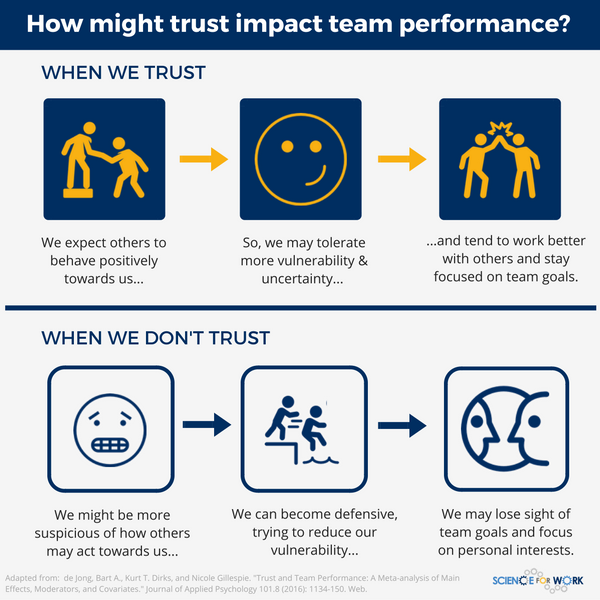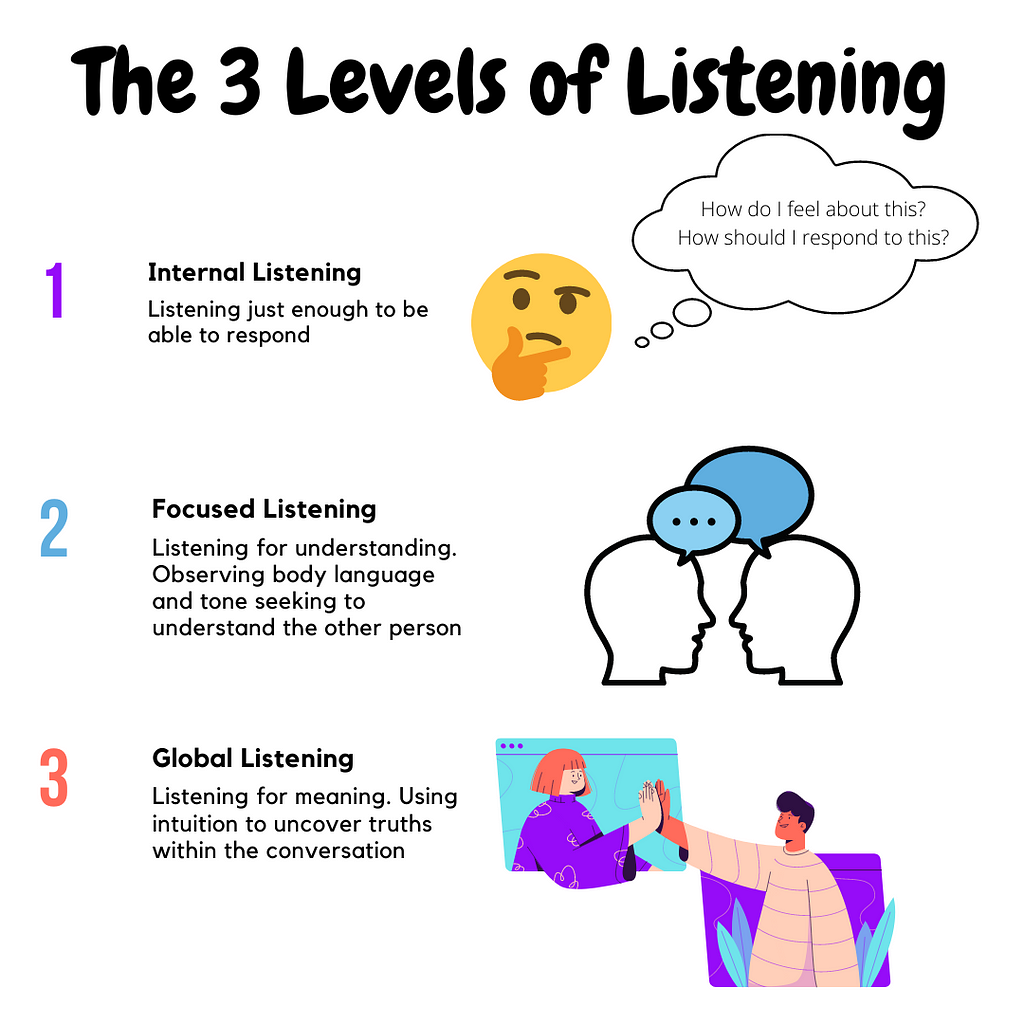 Photo by Thought Catalog on Unsplash
Photo by Thought Catalog on Unsplash
As an engineering manager, your success is tightly coupled with the success of the engineers on your team. A big part of your job is to build teams and maximize their outcomes and performance. Your ability to influence the success of your teams is directly correlated to the quality and depth of the relationships you are able to build with your team members. Through these relationships, you and your team members will be able to be vulnerable and grow together. However, none of that is possible if trust is not established first.
 Infographic by WENDY HIRSCH on Science For Work
Infographic by WENDY HIRSCH on Science For WorkOn “Trust: does it impact team performance… or not?” Wendy Hirsch states the power of trust as a predictor for team performance. How do we build that though? What are the key ingredients for building teams that trust each other and reap these performance benefits? Well, you might be surprised to learn it all starts with your one-on-one meetings.
One-on-one meetings are one of those things that seem straightforward and easy to do, yet many people have trouble getting them going effectively. On this article I’ll share what I believe one-on-one meetings should be about, considerations to keep in mind for them to be successful, and some ideas on how to get the conversations started.
What’s so great about One-on-Ones anyways?
There are two main reasons why you might want to have regular one-on-one meetings. First, it helps you create human connections with your direct reports. Remember, our goal is to build trust, and there can’t be trust if there’s no connection. This connection and ensuing personal relationship are where most of the magic happens. Not too dissimilar to other outcome-oriented relationships, like for instance that between psychotherapists and clients, where research has shown the stronger the relationship the more impactful and positive the expected outcomes (DeAngelis, 2019).
The second reason for having regular one-on-one meetings is, it provides a regular opportunity for people to speak privately with their managers about whatever they may need to discuss. In “The Manager’s Path: A Guide for Tech Leaders Navigating Growth and Change”, Camille Fournier stresses how important this regularity is.
Ok. I’m sold on One-on-Ones. Now what?
Now that we agree on one-on-ones being important and necessary, let’s talk about a few ground rules around them that’ll help you make the most of them.
When to start?
Right away. Especially if you are a people manager. It’s never too late to start though so no worries if you’re not doing them right now. Just get them on the calendar asap!
Confidentiality
There’s no oath, no client-provider privilege, no law nor regulation preventing you from sharing what’s discussed during a one-on-one meeting. That said, there’s an expectation of privacy you should be sensitive to. After all, we’re saying the one-on-one meeting is:
a regular opportunity for people to speak privately with their managers about whatever they may need to discuss
so privately pretty much goes out the window the moment you start sharing with other people what you learn during a one-on-one. A practice that’s worked for me is asking for permission to share. Whenever I hear something and feel like sharing it with someone else would be valuable to my direct report (e.g., they’re struggling with schooling issues for their kids and need to find a new school and I happen to know my manager went through something similar and could have useful information) I set the context for sharing this information and ask for their permission to do so or encourage them to reach out to the person I think could help them directly. As a general rule though, I recommend you use good judgement and keep conversations that are expected to be private, private.
Who sets the agenda?
This can be controversial. Some managers will tell you one-on-ones are their opportunity to get a status report from their team members and give them feedback or ask them for other work they need out of them. I like to approach this from a different perspective. I believe one-on-one meetings should be for and about the direct reports and as such, their agendas should be driven by them. Many engineering process frameworks provide for opportunities managers can use to get updates on the work that’s happening without using one-on-one time. One such opportunity could be a scrum or standup meeting for the project you’d like to get status on. When no such process exists, a simple email or chat message could get you the information you’re looking for.
Scheduling etiquette
Human beings are wired for craving predictability. We get stressed in the face of uncertainty and there’s plenty of uncertainty in our everyday lives. Let’s not make one-on-one scheduling time part of that problem. Find a time that works for both of you and stick to it. And by “stick to it” I mean, do your best to keep it in that agreed upon calendar slot, always be on time, and never cancel.
It’s tempting to think “I have so many other things to do. Maybe I can get out of this one-on-one meeting this week so I can make progress on task x, y, or z”. Just remember your main job is to make sure your team and team members are operating to the best of their potential and growing every day. Your one-on-one meetings are an essential tool to get that done. Assuming you have them on a weekly cadence, you get just 12 sessions per quarter. When you factor in sick days and PTO, that number could get reduced to single digits so cancelling even one puts you at a disadvantage.
What should we even talk about then?
Now we’re ready to talk about what the meeting looks like from the inside. What should you talk about? How should you go about it? Here’s what we have established so far:
- We want to build trust and strengthen the relationship.
- The agenda is driven by the direct report.
- It’s not a status report.
- The conversations are private.
With these in mind, I have a few thoughts on what these meeting could look like:
Topics
Encourage and empower your direct reports to come up with topics to discuss and share them with you ahead of time so you can prepare. Once you get this going, I promise you running out of things to talk about will be unlikely. When your direct reports don’t have something they want to discuss you can fall back to going over goals (personal or professional), doing a values definition exercise, or calibrating what success looks like for them. These are just ideas though, feel free to let your imagination run wild.
To feedback or not to feedback?
Feedback is one of the best presents you could give to anyone, especially people under your leadership. I absolutely use one-on-one time to share any feedback I have (be it formative or praise). That said, feedback is like fish, eat it fresh or it goes bad. When you wait too long to provide feedback, you risk losing the context of the situation, making the feedback less effective, or in some cases counterproductive. Whenever you have feedback to provide, do so promptly and don’t wait until the next one-on-one meeting to do so.
My direct report is talking. What do I do now?
Well, nothing. Just be present and listen. If you remember anything about this article, let it be this. We are predisposed to solving problems and biased for action. When you translate that to a conversation with a direct report, it can easily turn into, at best giving advice or at worse telling them exactly what to do to get through the situation they’re talking to you about. That’s not your job though. When you solve people’s problems, they don’t grow as much as when they solve them themselves. Your job as a manager is to empower the people on your teams to do just that. When you don’t and instead do it for them, you create other problems like over-dependence, burnout (yours), or becoming disconnected from the work that matters. In “The Coaching Habit: Say Less, Ask More & Change the Way You Lead Forever” Michael Bungay Stanier calls these “the three vicious circles that plague our workplaces” and with good reason. Instead, try listening and asking more questions.
Listening
Have you ever been in a conversation with someone and gotten the feeling they’re not listening to you? This is a fairly common situation due to people or even ourselves engaging only on the first of three levels of listening. These are:
- Level 1: Internal Listening. We’re focused on ourselves, our thoughts and feelings.
- Level 2: Focused Listening. We’re focused on the speaker, paying attention to their words, tone, and body language.
- Level 3: Global Listening. We’re focused on the speaker, noticing what’s being said and to what isn’t.
 Levels of Listening Infographic by Jose Arzuaga
Levels of Listening Infographic by Jose ArzuagaBeing a level 2 and level 3 listener takes intention and practice and mastering these will enable you to better understand the needs and wants of your direct reports. Now, the fact that you’re paying attention and listening to what they’re saying doesn’t mean you’re actually getting the message your direct report meant to send nor with the tone or feelings they were trying to convey. There are a myriad of reasons why some things could get lost in translation. However, there are techniques you could use to address this scenario. One such technique is practicing reflective listening. Reflective listening involves hearing and understanding what the other person is communicating through words or body language and then reflecting those back. With reflective listening, you make sure your understanding of the message is accurate. This technique has the added bonus of sending a powerful message to the speaker that says “I’m listening to you. I understand what you’re saying. I care”.
Asking more Questions
Just ask more questions. Sounds easy right? Well it can be, if you know what to ask. When wanting to create moments of reflection or deep insights during your one-on-one meeting, you can turn to powerful questions. Powerful questions are questions you can ask to deepen a conversation, leading to new insights. They can help remove mental roadblocks and encourage people to try new problem-solving techniques. These types of questions are known to help people see things from a fresh perspective, put a halt on confusion, and provide opportunities for people to solve their own problems. Powerful questions are characterized by being open ended, neutral (do not provide advice), simple, brief, and unexpected.
One of the most powerful questions I like to ask is “What’s the real challenge here for you?”. This question invites people to focus and re-assess their assumptions on what the problem is, often leading them to discover the real problem they should be addressing.
There are plenty of resources available online with ideas of powerful questions for any imaginable situation. One of my favorites is Slack’s VP of Engineering Rukmini Reddy’s framework for one-on-one meetings, which outlines questions for different types of interactions (e.g. first conversation, follow-ups, etc.).
Conclusion
There’s a quote from Simon Sinek I always keep in mind. “A team is not a group of people who work together. A team is a group of people who trust each other.” This quote highlights the importance of building trust with your team members and your one-on-one meetings with them are one of the best ways of doing so.
“A team is not a group of people who work together. A team is a group of people who trust each other.”
— Simon Sinek
My goal with this article was to introduce you to the type of one-on-one I like having, both with my direct reports and with my manager. Your style might look a bit (or a lot) different and that’s ok. The most important takeaway I’d like for anyone reading this to get is, there’s power in human connection and talking to each other is a great way to build those. I’d love to learn about what other ways you use to build trust and connection with your teams. Feel free to tell me in the comments or to share any feedback or reactions you had to this post.
One-on-One meetings as drivers for building trust was originally published in Walmart Global Tech Blog on Medium, where people are continuing the conversation by highlighting and responding to this story.
Article Link: One-on-One meetings as drivers for building trust | by José Arzuaga | Walmart Global Tech Blog | Medium